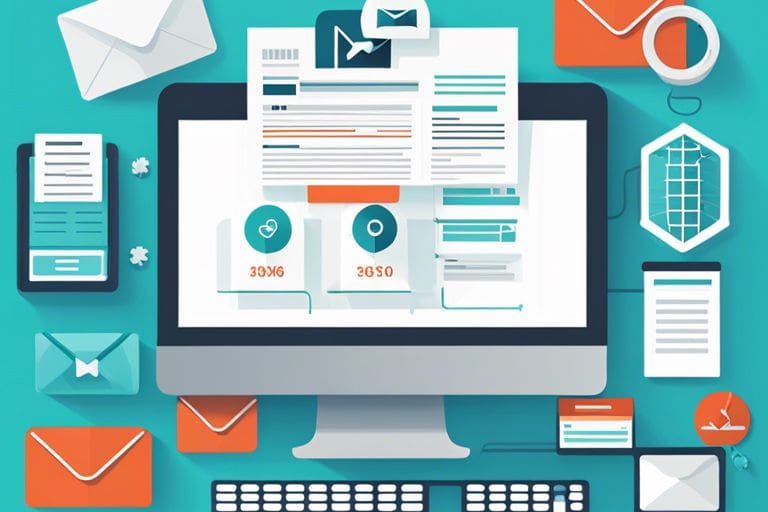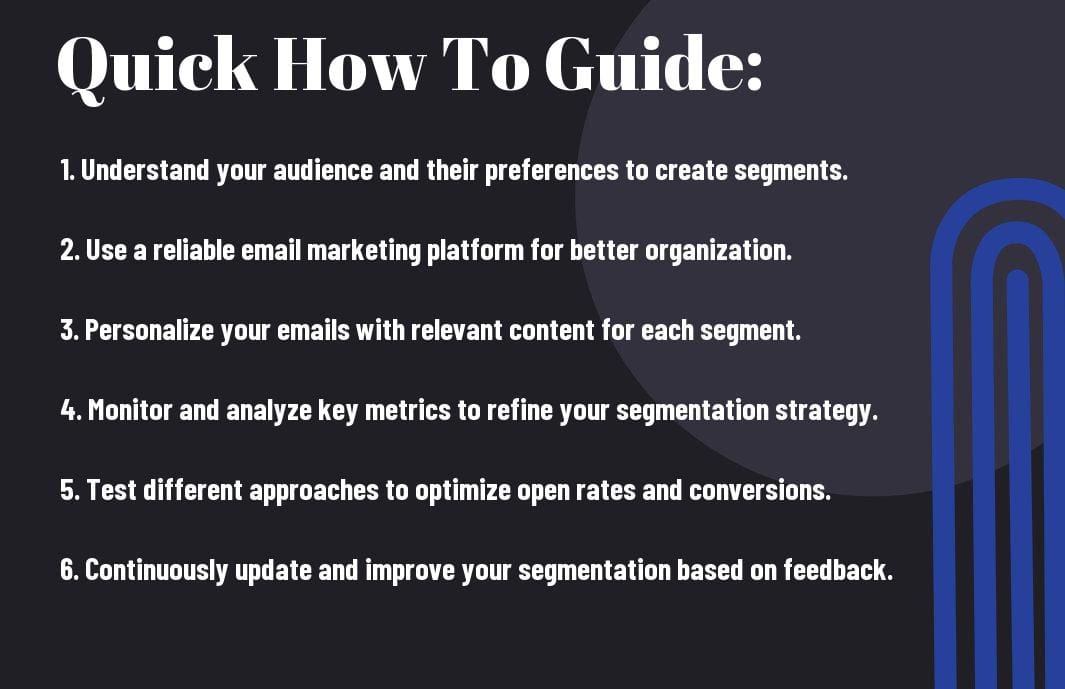Many businesses struggle to harness the full potential of their email marketing efforts, often leading to low engagement and conversion rates. In today’s digital age, where personalization is key, mastering email segmentation is important for success. This expert guide will provide you with proven strategies and best practices to take your email marketing campaigns to the next level. From segmenting your email list based on behavioral data to crafting compelling personalized content, you will learn how to increase open rates, click-through rates, and ultimately drive revenue. Stay ahead of the competition and achieve exceptional results with our comprehensive guide to mastering modern email marketing and segmentation.
Key Takeaways:
- Segmentation is crucial: In modern email marketing, segmenting your audience based on demographics, preferences, behaviors, or engagement levels is necessary for crafting personalized and targeted email campaigns.
- Automation saves time and improves efficiency: Use automation tools to streamline your email marketing efforts, such as setting up automated triggers based on user actions, sending personalized follow-up emails, and scheduling campaigns in advance.
- Regularly analyze and optimize your email campaigns: Track key metrics like open rates, click-through rates, and conversion rates to evaluate the performance of your email campaigns. Use this data to make informed decisions and continuously optimize your email marketing strategy for better results.


Crafting Your Email Marketing Foundation
How to Build a Robust Email List
Some of the most critical steps in mastering modern email marketing revolve around building a strong foundation for your email lists. To start, ensure that you capture email addresses through various touchpoints on your website, social media platforms, and other marketing channels. Offering valuable incentives such as discounts or exclusive content can entice visitors to subscribe to your list, helping you grow a healthy and engaged audience.
Tips for Segmenting Your Audience Early On
Some email marketers underestimate the power of segmentation in their campaigns. By dividing your audience based on common interests, behaviors, or demographics, you can tailor your messaging to suit each group’s preferences. For instance, if you’re a fashion retailer, segmenting your list by gender or shopping habits can lead to more personalized and relevant content for your subscribers. Knowing your audience inside out can significantly boost engagement and conversions.
- Use customer data to create targeted segments
- Personalize emails based on subscriber preferences
- Track and analyze engagement metrics to refine your segments
Advanced Segmentation Techniques
All marketing experts understand the importance of advanced segmentation techniques to enhance the effectiveness of email marketing campaigns. By segmenting your email list based on various factors, you can tailor your messages to specific audiences, increasing engagement and conversion rates.
- Factors That Influence Email List Segmentation
Demographics Behavior Age, gender, location Purchase history, website interactions - Personalization, Relevance, and Targeting are crucial for successful segmentation.
- Using data-driven insights can help you create hyper-targeted segments.
- Thou shall continually analyze and update your segmentation strategies based on performance metrics.
How-to Implement Behavioral Segmentation for Increased Engagement
On your journey to mastering email marketing, implementing behavioral segmentation is key to engaging customers on a more personal level. By tracking and analyzing subscriber behavior, you can send targeted emails based on their interactions with your brand.
An effective behavioral segmentation strategy involves categorizing subscribers based on their actions, such as email opens, clicks, and purchases. By tailoring content to fit their preferences and behaviors, you can increase engagement and drive conversions. Behavioral segmentation allows you to create dynamic, personalized emails that are more likely to resonate with your audience.
Behavioral segmentation can help you build stronger customer relationships and improve overall campaign performance. By sending the right message to the right person at the right time, you can boost your email marketing ROI significantly.
Mastering Email Content and Design
Tips for Crafting Compelling Email Copy
Now, in email marketing, crafting compelling email copy is a crucial skill to develop. Some key tips to keep in mind include personalizing the message, keeping it concise and to-the-point, including a clear call-to-action, and testing different subject lines for optimal results. Assume that by following these guidelines, you can increase engagement and conversion rates.
Designing Emails for Maximum Impact
Email design is another crucial aspect of mastering email marketing. Craft visually appealing emails that are mobile-responsive and incorporate branding elements to enhance recognition. Consider using eye-catching visuals and easy-to-read fonts to capture the reader’s attention. Recall, the goal is to create a seamless user experience that encourages click-through rates and conversions.
Optimizing Email Campaigns
How-to Use A/B Testing to Refine Your Approach
Your email marketing campaigns can always benefit from refinement. One of the most effective ways to do this is by using A/B testing. By creating two versions of an email with slight variations in subject lines, content, or visuals, you can test which version performs better with your audience. This data-driven approach allows you to optimize your campaigns based on real-time feedback and increase the effectiveness of your email marketing efforts.
Analyzing Campaign Data for Continuous Improvement
To maintain a successful email marketing strategy, it is crucial to continuously analyze campaign data. By closely monitoring key metrics such as open rates, click-through rates, and conversion rates, you can gain valuable insights into the performance of your campaigns. Identify trends, patterns, and areas for improvement to continuously refine your email marketing strategy and achieve better results with each campaign.
Automation and Personalization Strategies
Implementing Automation While Maintaining a Personal Touch
For successful email marketing campaigns, it is imperative to incorporate automation while still maintaining a personal touch. Utilize automated workflows to send targeted messages based on subscriber behavior and preferences. Personalize emails with the recipient’s name, past interactions, and tailored content to create a sense of individualized communication.
Advanced Personalization Tactics to Boost Open Rates
Strategies to enhance email open rates include advanced personalization tactics that go beyond basic demographic information. Incorporate dynamic content, such as product recommendations based on past purchases or personalized subject lines to capture the recipient’s attention. A personalized approach not only increases open rates but also fosters stronger customer relationships.
| Strategies | Benefits |
| Utilize automated workflows | Efficient and targeted communication |
| Personalize content | Enhanced engagement and conversion rates |
Personal: Implementing personalized elements in email marketing can significantly impact campaign success. By segmenting your audience based on behavior and preferences, you can tailor content to individual recipients, increasing relevance and engagement. Personalization goes beyond just using a first name; include dynamic elements that adapt to each subscriber’s unique interests and interactions with your brand.
- Dynamic content
- Personalized product recommendations
Legal Compliance and Best Practices
How to Ensure Your Email Marketing is GDPR Compliant
Not adhering to legal requirements when conducting email marketing can lead to serious consequences for businesses. To ensure your email marketing is GDPR compliant, it is imperative to obtain clear consent from individuals before sending them marketing emails. This consent should be freely given, specific, informed, and unambiguous. Additionally, providing recipients with an option to easily unsubscribe from your emails is crucial for compliance.
Maintaining Ethical Standards in Email Segmentation
One of the key factors in maintaining ethical standards in email segmentation is ensuring that you are not discriminating or stereotyping individuals based on sensitive information such as race, gender, religion, or sexual orientation. It is important to remember that your email subscribers are real people with varying preferences and characteristics. Segmentation should be based on relevant and non-discriminatory criteria to avoid alienating or offending recipients.
Above all, it is crucial to prioritize the privacy and respect of your subscribers’ personal information. Respecting their privacy builds trust and loyalty, ultimately leading to better engagement and conversions.
To wrap up
Hence, mastering modern email marketing and segmentation is crucial for any business looking to engage with their audience effectively. By understanding the importance of personalization, segmentation, automation, and analytics, businesses can create targeted and relevant email campaigns that drive results. Remember to continuously test and optimize your strategies to ensure the highest level of success. With this expert guide, you are well on your way to becoming a pro in the world of email marketing and segmentation.
FAQ
Q: Why is email marketing important for business growth?
A: Email marketing is a crucial tool for businesses as it allows direct communication with potential and existing customers. It helps to build brand awareness, drive website traffic, increase sales, and nurture customer relationships effectively.
Q: What are the key elements of a successful email marketing campaign?
A: A successful email marketing campaign requires a clear strategy, relevant and engaging content, a targeted audience segmentation, personalized messaging, attention-grabbing subject lines, mobile optimization, and regular performance tracking and analysis.
Q: How can segmentation improve the effectiveness of email marketing campaigns?
A: Segmentation divides your email list into smaller, targeted segments based on demographics, behaviors, or preferences. This allows you to send more personalized and relevant content to specific groups, increasing open rates, click-through rates, conversions, and ultimately, ROI.




